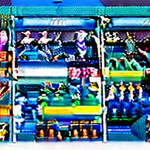Demystifying Deep Learning with Python: A Beginner’s Guide
Introduction to Deep Learning with Python
Embark on a transformative journey into the world of Deep Learning with this comprehensive beginner’s guide, meticulously crafted to empower you with the knowledge and skills to harness the potential of this revolutionary field. This tutorial offers a practical, hands-on approach to understanding Deep Learning concepts, constructing effective models using Python, and exploring its diverse applications. No prior experience is required; this guide will take you from novice to proficient, equipping you with the tools to build intelligent systems. Deep learning, a subset of machine learning within the broader realm of artificial intelligence (AI), leverages artificial neural networks with multiple layers to extract intricate patterns and higher-level features from raw data. This deep learning python tutorial will illuminate the core principles behind these networks, demonstrating how they learn complex representations, enabling machines to perform tasks previously thought exclusive to human intelligence. Python, renowned for its versatility and rich ecosystem of libraries, serves as the perfect language for deep learning exploration. We will utilize powerful Python libraries like TensorFlow and PyTorch, providing you with practical experience in building and training your own neural networks python. From image recognition to natural language processing, this beginner’s guide to deep learning will open doors to a world of possibilities. This journey will cover essential concepts such as setting up your Python environment for deep learning, understanding different deep learning architectures, and building your first deep learning model. We will delve into the practical applications of deep learning, showcasing real-world examples that demonstrate its transformative power across industries. Imagine building systems that can understand images, process natural language, and even make decisions – all powered by the principles of deep learning. By the end of this guide, you will have a solid foundation in deep learning, python for deep learning, and machine learning, enabling you to explore more advanced topics and contribute to this exciting field. Whether you are a data scientist, a programmer, or simply curious about the potential of AI, this beginner’s guide to deep learning applications will provide you with the knowledge and inspiration to begin your deep learning journey.
What is Deep Learning?
Deep learning, a specialized subset of machine learning, harnesses the power of artificial neural networks, specifically those with multiple layers, to extract intricate, higher-level features directly from raw data. This process can be visualized as a network of interconnected nodes, much like a digital brain, where each node processes and relays information to the next. These nodes are strategically organized into layers: an input layer receives the initial data, hidden layers perform complex computations, and an output layer delivers the final result. This layered architecture is what allows deep learning models to excel in tasks such as image recognition, natural language processing, and other complex problem-solving domains. Activation functions within these nodes introduce non-linearity, a crucial element enabling the network to discern and learn complex, non-linear patterns inherent in real-world data. This capability sets deep learning apart from traditional machine learning algorithms, allowing it to tackle intricate challenges with remarkable accuracy. A beginner’s guide to deep learning with Python often starts with understanding these fundamental building blocks. This journey into deep learning applications begins with grasping the interplay of layers, nodes, and activation functions, paving the way for building intelligent systems. Deep learning models, especially when implemented using Python, thrive on large datasets. The more data a model is trained on, the better it becomes at recognizing patterns and making accurate predictions. This is why data science plays a crucial role in deep learning. Python, with its rich ecosystem of libraries like TensorFlow and PyTorch, provides the perfect environment for building and training these data-intensive models. As a powerful tool in artificial intelligence, deep learning is transforming industries by powering innovations such as self-driving cars, personalized recommendations, and advanced medical diagnostics. The ability to process vast amounts of data and extract meaningful insights makes deep learning a cornerstone of modern AI. Python’s versatility and ease of use make it the language of choice for many deep learning practitioners. From building simple neural networks to complex deep learning architectures, Python offers a comprehensive toolkit for both beginners and experts. A deep learning Python tutorial can provide hands-on experience with these concepts, bridging the gap between theory and practice. Whether you’re interested in neural networks, exploring the power of AI, or diving into the world of machine learning, Python offers a robust and accessible pathway to mastering deep learning. This synergy between deep learning, Python, and data science has propelled the field forward, creating exciting opportunities for innovation across various domains. As you embark on your deep learning journey, understanding these interconnected concepts will be key to unlocking its full potential.
Setting Up Your Python Environment
Setting up your Python environment for deep learning is a crucial first step in your journey towards mastering this transformative field. A well-configured environment streamlines your workflow and allows you to focus on building and training neural networks. Begin by installing the essential Python libraries that power deep learning applications. TensorFlow, developed by Google, and PyTorch, created by Meta, are two leading choices, each with its own strengths. Using pip, the Python package installer, the process is straightforward: simply type ‘pip install tensorflow’ for TensorFlow or ‘pip install torch torchvision torchaudio’ for PyTorch, including torchvision and torchaudio for computer vision and audio processing capabilities, respectively. Detailed installation guides and troubleshooting tips are available on the respective library websites, catering to various operating systems and hardware configurations. For beginners embarking on a deep learning python tutorial, these resources offer invaluable support. This beginner’s guide to deep learning will equip you with the knowledge to navigate these installations seamlessly. Leveraging Python for deep learning opens doors to a world of AI and machine learning applications. Choosing the right environment for your needs is paramount. Consider factors like community support, available resources, and specific project requirements when making your decision. Anaconda, a popular Python distribution, provides a pre-configured environment with many scientific computing libraries, including TensorFlow and PyTorch, simplifying the setup process. It also offers tools for managing different project environments, which is particularly useful when working with multiple deep learning projects or libraries. Virtual environments are another valuable tool for isolating project dependencies and preventing conflicts between different libraries. They ensure that your deep learning projects remain independent and stable, regardless of other Python projects on your system. This structured approach is essential for maintaining a clean and efficient workflow, particularly as you delve deeper into neural networks python and explore advanced deep learning architectures. Exploring deep learning applications requires a robust and adaptable environment, and utilizing these tools will contribute significantly to your success in the field of artificial intelligence. Deep learning python tutorials often emphasize the importance of a well-structured environment, as it forms the foundation for all subsequent learning and experimentation. By setting up your environment effectively, you’ll be well-prepared to explore the exciting world of neural networks python, AI, and machine learning.
Building Your First Deep Learning Model
Let’s embark on building our first deep learning model, an image classifier, using Keras, a high-level API within TensorFlow, that simplifies the creation of neural networks. This example serves as a practical introduction to how neural networks can learn to distinguish between different types of images, a foundational concept in many deep learning applications. We will be using a sequential model, which is a linear stack of layers, perfect for a beginner’s guide to deep learning. This model, while simple, embodies the core principles of neural networks and their application in machine learning. The first layer, a Flatten layer, transforms the 2D image data into a 1D vector, preparing it for processing by the subsequent dense layers. This is a crucial step in preprocessing data for neural network input. The input_shape parameter specifies the dimensions of the input images, in this case, 28×28 pixels, which is a common size for datasets like MNIST. The next layer, a Dense layer, is a fully connected layer where each neuron is connected to every neuron in the previous layer. We’re using 128 neurons in this layer, and the ‘relu’ activation function introduces non-linearity, allowing the network to learn complex patterns. This is a critical aspect of deep learning, as linear models are insufficient for capturing the intricate relationships in real-world data. The final Dense layer has 10 neurons, corresponding to the 10 classes of images we want to classify. This layer does not have an activation function, as it will output raw scores for each class. This model, though basic, demonstrates the core principles of building a neural network using Python for deep learning. This example is a stepping stone for more complex models and applications. This practical example is a great way to understand the basics of how to use Python for deep learning. This is a fundamental concept for any beginner’s guide to deep learning. This model is a great starting point for those new to artificial intelligence and machine learning. Furthermore, understanding the structure of this model is crucial for grasping more complex neural network architectures used in various deep learning applications. The choice of the number of neurons in each layer, the activation functions, and the overall architecture are all important design decisions that impact the performance of the model. This example provides a clear and concise introduction to these concepts, setting the stage for deeper exploration of neural networks python. The development of this model underscores the accessibility of deep learning with Python, thanks to user-friendly libraries like Keras. This model is a practical example of how you can leverage Python for deep learning. This is a key concept in AI and machine learning. This example is a starting point for many deep learning applications. This example is a great way to learn about neural networks in Python.
Exploring Deep Learning Architectures
Deep learning architectures are not one-size-fits-all; they are meticulously designed to address specific types of data and tasks. Convolutional Neural Networks, or CNNs, for example, are the workhorses of image recognition and computer vision. Their unique structure, which involves convolutional layers that automatically learn spatial hierarchies of features, makes them incredibly adept at identifying patterns within images. Think of how a CNN can differentiate between various breeds of dogs or recognize objects in a self-driving car’s visual field, showcasing the real power of these neural networks in the field of artificial intelligence. This makes CNNs a vital component in many deep learning applications.
Recurrent Neural Networks, or RNNs, on the other hand, excel when it comes to sequential data such as text or time series. The key innovation of RNNs is their ability to maintain a hidden state, which acts like a memory of previous inputs. This allows them to capture the context and dependencies between data points in a sequence. Consider how an RNN might be used in natural language processing to understand the sentiment of a text or to translate between languages. This capability of handling sequences makes RNNs indispensable in many AI applications, especially where the order of information is crucial. Understanding these nuances is essential for anyone diving into a deep learning python tutorial.
Transformers, a more recent innovation in deep learning, have revolutionized the field of natural language processing and are increasingly being applied to other domains. Unlike RNNs, transformers use attention mechanisms to weigh the importance of different words in a sentence, allowing them to process the entire input sequence in parallel. This approach has significantly improved the performance of language models, making transformers the foundation for many advanced AI systems, such as state-of-the-art chatbots and large language models. Learning about transformers is critical for anyone interested in the cutting edge of deep learning and machine learning. The development of these architectures showcases how neural networks python has evolved to tackle complex challenges.
The choice of architecture also depends heavily on the specific problem and available data. For instance, if you’re working with a small dataset of images, a pre-trained CNN model could be fine-tuned for your specific task using transfer learning, saving substantial computational resources and training time. Conversely, for a language understanding task, you might need to train a transformer model from scratch, which requires a large amount of text data and processing power. Choosing the right architecture is a key element in data science projects that involve deep learning applications. This demonstrates the importance of a beginner’s guide to deep learning that covers various architectures, allowing for informed decision-making.
Furthermore, these architectures are not mutually exclusive; hybrid models that combine the strengths of multiple architectures are increasingly common. For example, a system might use a CNN to extract features from images and then feed those features into an RNN to generate image captions. This combination allows for complex tasks that leverage the strengths of different architectures. Exploring these types of hybrid models is crucial for anyone seeking advanced applications of deep learning in areas such as artificial intelligence and robotics. This level of flexibility and adaptability is a testament to the ongoing advancements in the field and underscores why python for deep learning is such a powerful tool.
Real-World Applications and Continued Learning
Deep learning is indeed revolutionizing numerous industries, marking a significant shift in how we approach complex problems. In computer vision, the impact is undeniable; self-driving cars rely heavily on sophisticated neural networks to interpret their surroundings in real-time, while facial recognition technology, often powered by deep learning algorithms, is now commonplace in security systems and even personal devices. These applications showcase the power of deep learning to process and understand visual information with a level of accuracy previously unattainable. Natural language processing (NLP) is another area that has witnessed remarkable progress thanks to deep learning. Chatbots, once clunky and limited, now engage in increasingly human-like conversations, and sentiment analysis tools accurately gauge public opinion from vast amounts of textual data. This capability to understand and generate human language is transforming customer service, marketing, and even political analysis.
Robotics, too, is being reshaped by deep learning. Complex tasks such as object manipulation, which require precise control and adaptability, are now being tackled by robots equipped with neural networks trained on extensive datasets. These advancements are paving the way for more sophisticated automation in manufacturing, healthcare, and logistics. The ability of deep learning models to learn from data and generalize to new situations is what makes them so effective across these diverse applications. Consider the field of medical diagnosis, where deep learning models are now being used to analyze medical images with comparable, and in some cases, superior accuracy to human experts, leading to earlier and more precise diagnoses of various diseases. The potential for deep learning to improve healthcare outcomes is enormous and continues to expand.
Furthermore, the financial sector is increasingly leveraging deep learning for fraud detection, algorithmic trading, and risk assessment. These tools can analyze complex patterns in financial data to identify anomalies and potential risks that might be missed by traditional methods. This demonstrates the ability of deep learning not just to handle visual or textual data but also to effectively analyze numerical data. As we continue to generate more data than ever before, the need for these powerful analytical techniques is growing, making deep learning a crucial skill for the modern professional. For those looking for a practical deep learning python tutorial, numerous online resources and beginner’s guide to deep learning are available to help build foundational skills. Learning about neural networks python and how to use python for deep learning is essential to leverage this technology.
The widespread adoption of deep learning has also spurred the development of user-friendly tools and frameworks, such as TensorFlow and PyTorch, which greatly simplify the process of building and deploying neural networks. These libraries, often used in AI and artificial intelligence projects, have lowered the barrier to entry, allowing more individuals and organizations to explore the potential of deep learning. This accessibility has further fueled innovation, leading to new and unexpected applications. The use of machine learning techniques combined with deep learning has opened new avenues for data analysis and prediction, which is revolutionizing numerous industries. The ability to process vast amounts of data and extract meaningful insights is becoming increasingly important in today’s world.
To continue your deep learning journey, we highly recommend exploring the official documentation for TensorFlow and PyTorch. These resources offer in-depth tutorials, examples, and explanations of the underlying concepts. Online platforms like Coursera, edX, and Udacity also provide a wealth of courses on deep learning applications, ranging from beginner-friendly introductions to more advanced topics. Remember, mastering deep learning requires consistent practice and a commitment to continuous learning, but the rewards, both in terms of professional development and the ability to contribute to groundbreaking advancements, are immense. The combination of deep learning and AI is poised to transform our world in profound ways, and understanding these technologies is vital for navigating the future.


